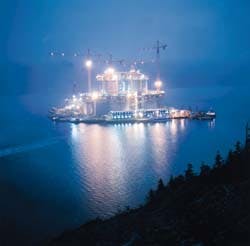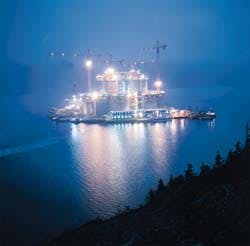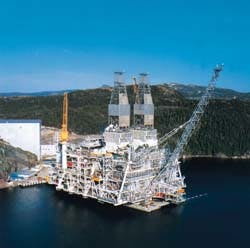Patrick Crow
Energy Policies Editor
Construction of the gravity base structure for Newfoundland's Hibernia oil field developement project proceeds at a deepwater site at Bull Arm, Trinity Bay, Newf. Photo courtesy Hibernia Management & Development Co. Ltd.
When the long-delayed Hibernia field project off eastern Newfoundland begins producing oil late next year, it is expected to become the catalyst for development of more fields on the Grand Banks.
Completion of the massive $5 billion (Canadian) Hibernia project, together with the incentive of a recent provincial royalty schedule, have created something of an oil boomlet in Newfoundland.
Owners of Terra Nova field near Hibernia are expected to unveil plans soon for development of their field, and Whiterose and several other Grand Banks discoveries could be developed later.
Meanwhile, exploration remains hot on the west side of the island province, although no commercial discoveries have been disclosed. Newfoundland's untapped potential and how the province is trying to attract companies to assess that potential will be covered in a follow-up article next week.
Hibernia progress
Hibernia oil field, with proved reserves of 615 million bbl, is 315 km southwest of St. John's, Newf., in 80 m of water.
The discovery well was drilled in 1979, and the field was delineated during 1980-84. But lower oil prices and high development costs hobbled the project's economics.
It was not until fall 1990 that Hibernia owners and the federal and Newfoundland governments concluded legal and financial agreements that would allow the project to proceed.
Hibernia said total operating costs for the producing life of the project are projected at $6.258 billion, more than $300 million under a 1994 estimate. The estimated breakeven crude price is $12.95/bbl in constant 1995 U.S. dollars.
Drilling production wells will cost $2 billion. Construction of the platform will cost about $5.819 billion, of which $4.85 billion already has been spent. Of that total, $2 billion was spent in Newfoundland and another $1.35 billion in other Canadian provinces.
Hibernia has seen numerous delays in the past, but is fully on schedule now.
The field is expected to reach a plateau of 135,000 b/d in mid-2000 from the Cretaceous Hibernia sand at 3,700 m and Cretaceous Avalon sand at 2,400 m. Production life is estimated at 19 years.
When production begins in late 1997, Hibernia will represent about 12% of Canada's total oil production. Hibernia crude is 32° gravity and has low sulfur content.
Owners are Mobil Oil Canada 33.125%, Chevron Canada Resources 26.875%, Petro-Canada 25%, Canada Hibernia Holding Corp. 8.5%, and Murphy Atlantic Offshore Oil Co. 6.5%.
The field was named for the S.S. Hibernia, a ship that assisted in laying communications cable between Heart's Content, Newf., and Ireland in the 1800s.
Platform design
Hibernia will be developed with a concrete gravity base structure (GBS) that will store 1.3 million bbl of oil for shuttle tankers to move to market. The GBS is designed to withstand 10 ft waves as well as icebergs common along the Grand Banks in the spring. In early July the GBS was 89% complete.
Hibernia Management & Development Co. Ltd. says the GBS is an innovative design. Although numerous GBS platforms have been installed in the North Sea, the Hibernia GBS has an icewall with 16 exterior teeth designed to absorb the impact of a 6 million ton iceberg.
Icebergs in the region are typically about 300,000 tons, because the relatively shallow waters won't allow larger ones and the field is near the southern limits for sea ice.
Operators also have planned an "iceberg management program" under which icebergs will be tracked, and those coming too close to the platform will be nudged off track.
The GBS is being built by slipforming, the continuous placement of reinforcing bars and pouring of concrete, which allowed about 1 m of height to be added during each day of pouring.
Inside the GBS icewall are two drill shafts, a utility shaft, and a riser shaft. They extend from the base through the roof of the GBS to support the topsides facilities.
The cylindrical part of the GBS is 106 m in diameter and 85 m high. The four GBS shafts are 111 m high, or 26 m above the GBS roof.
Crude will be offloaded through a nearby single point mooring system into two, 850,000 bbl ice-reinforced, double hull tankers that will carry the oil to Canadian and U.S. refineries. About 900,000 bbl can be offloaded in 24 hr.
The GBS will weigh about 680,000 tons when completed and ballasted. Another 450,000 tons of magnetite, a dense form of iron ore, will be added as ballast when the platform is installed offshore.
Topsides, timetable
About a mile away from the GBS construction site in Trinity Bay's Bull Arm, about 130 km northwest of St. John's, the topsides facilities are 94% complete.
Topsides facilities have an oil handling design capacity of 150,000 b/d. They include process and living quarters modules built in South Korea, mud and utility modules built in Italy, and a wellhead module constructed at Bull Arm.
The platform will accommodate about 64 wells, drilled to an average depth of 9,000 m, and some with a horizontal displacement of as much as 7,500 m from the platform. More wells will be drilled later with floating rigs, completed subsea, and tied into the platform.
Two supply vessels, the Norseman and Nascopie, were built at Marystown, Newf., and are working in the North Sea with Newfoundland crews until they are needed at Hibernia.
The topsides and GBS are due to be completed by November. This month simulated drilling exercises will begin for the topsides to test mud and drilling systems.
The GBS will be mated to the topsides next March, and the completed production platform will be towed to the Hibernia field site in June.
Drilling will begin in August 1997, and production will start in December 1997, with the first offloading of crude in February 1998. Operators will begin reinjecting gas and injecting water in June 1999.
About 800 workers will be required to operate the platform during the production phase.
The Hibernia partners are studying three deepwater locations in western Newfoundland for a transshipment facility to handle oil from Hibernia and other offshore projects. One is Vitol SA's Come By Chance refinery. A decision is expected soon.
They initially considered a terminal at Port Hawkesbury, N.S., but dropped it for political reasons and began looking in Newfoundland.
The transshipment terminal would eliminate the need for a third Hibernia shuttle tanker later and could serve Terra Nova and Whiterose fields as well. All three fields have some common industry partners.
The Newfoundland government already is trying to sell the $500 million Bull Arm construction site, with the likely purchasers being other oil field operators.
The camp has housing for 3,000 persons, a drydock, rebar prefab building, concrete batch plant, and other facilities.
During its construction period, the Hibernia project has created about 28,900 man-years of employment in Canada, with 19,000 in Newfoundland. At the peak of the construction phases, 6,800 jobs were created in Canada.
Terra Nova
About 35 km east of Hibernia, Petro-Canada and partners plan to develop the 405 million bbl Terra Nova field in 90-100 m of water.
The owners are Petro-Canada 49.2%, Mobil Oil Canada 20.7%, Husky 15.8%, Murphy Oil Co. Ltd. 10.7%, and Mosbacher Operating Ltd. 3.6%.
Talisman Energy Inc. holds a small interest in the far eastern block that apparently underlies part of the field. That area has not been tested by drilling, but seismic data indicate it may contain as much as 100 million bbl of recoverable oil. It will be drilled after Terra Nova production begins.
Petro-Canada, which found the field in 1984, expects it will be developed through a floating production system, based on either a semisubmersible rig or a ship. Construction would begin in 1998.
The field will produce about 100,000 b/d of low sulfur, 33° gravity crude and 75 MMcfd of gas beginning in 2001 or earlier, depending on the development mode selected.
Petro-Canada expects to drill 19 production and 13 pressure maintenance wells in the upper Jurassic Jeanne d'Arc sand at 3,200 to 3,700 m. Individual well production rate is estimated at more than 20,000 b/d. Field life is projected at 15-20 years.
The subsea wellheads will be sunk in "glory holes" below the seabed to protect them from ice gouging.
Petro-Canada and partners have spent $400 million so far on Terra Nova, and pre-production development costs for the project, excluding tankers, is estimated at less than $2 billion.
Expenditures for capital and operating costs through the producing life of the field could total $4 billion, excluding tanker costs.
Aerial view is of the Hibernia drilling-production platform topsides under construction at Bull Arm, Newf. Photo courtesy Hibernia Management & Development Co. Ltd.
Royalties, alliances
Terra Nova partners continue to negotiate with the Newfoundland government on a royalty schedule. It is expected to be similar to the province's generic royalty regime.
Newfoundland's Gibbons said, "Agreement has been reached on most of the substantive issues, and submission of a development plan application is imminent."
In March, Petro-Canada named three industry alliances to perform competitive production design studies for Terra Nova: Alliance Newfoundland, the Grand Banks Alliance, and Avalon Offshore Alliance. Alliancing also is expected to be used in the production phase.
The alliance approach replaces the traditional contractor-client relationship with a partnership in which the exploration and service companies share the risks and rewards of cost overruns and underruns.
The alliances will recommend the optimum floating production system to develop the Terra Nova oil field as well as the associated costs and schedule.
They will submit their proposals Oct. 7, and Petro-Canada hopes to choose the preferred development option and alliance group by yearend or early 1997.
For political reasons, Petro-Canada has asked the three alliances also to examine the possibility of producing the field with a floating concrete platform, which could be constructed in Newfoundland.
Gary Bruce, Petro-Canada's vice president for frontiers and international operations, said a decision will be made at yearend 1997 on whether to develop the field. Then it will take as long as 31/2 years to engineer and build the production system.
He said, "Floating production systems are proving to be the practical choice for smaller fields. Terra Nova will be the proving ground of all projects that will come afterward" on the Grand Banks.
Recently, Petro-Canada agreed to give Norsk Hydro AS about 5% of Hibernia and 15% of Terra Nova in exchange for small interests in Norsk's ownership of two Norwegian fields and as much as $90 million cash.
Amoco Canada heightened interest in Terra Nova last year when it bid $90 million for exploration rights to about 44,500 acres adjacent to the field. It was the largest single work expenditure commitment for rights off Newfoundland. Amoco plans to drill one and perhaps two wells in 1997.
Whiterose
Husky Oil Operations Ltd. is another active operator on the Grand Banks. It holds a fifth of the license area in the Jeanne d'Arc basin.
It plans to develop Whiterose oil and gas field, 50 km east of Hibernia and 320 km east of St. John's, in 125 m of water.
Interests are operator Husky 42%, Petro-Canada 25%, Talisman 17%, and Gulf Canada and Parex 8% each.
Husky plans to drill as many as four delineation wells beginning in 1998. Whiterose could be producing by 2004, rising to an average 75,000 b/d and peaking at 100,000 b/d.
The 1984 discovery well cut a column of 100 m net pay in the Ben Nevis/Avalon sand. Reserves are estimated at 250 million bbl and 1.5 tcf.
Husky plans a seismic program next year, followed by four delineation wells in 1998-99. It would submit development plans near 2000 and bring the field on stream in 2004.
For development, it anticipates 13 horizontal or highly deviated production wells and 10 injection wells. Production would be about 75,000 b/d through a floating vessel.
Copyright 1996 Oil & Gas Journal. All Rights Reserved.


